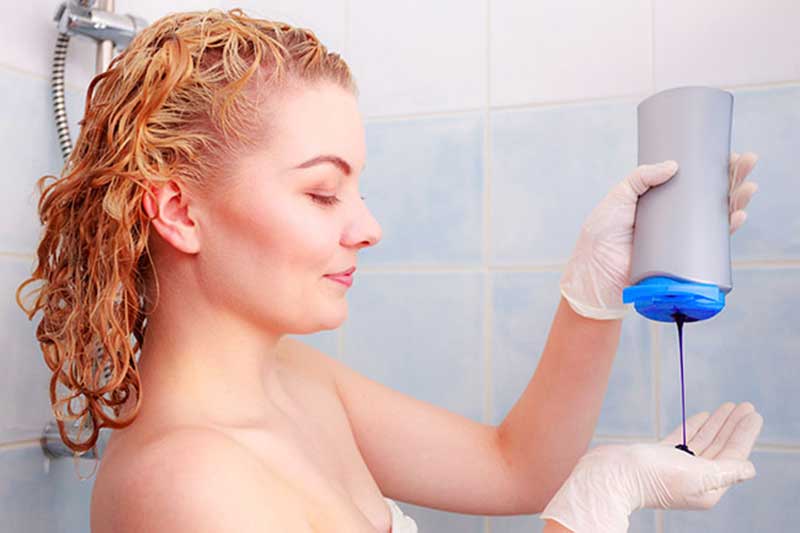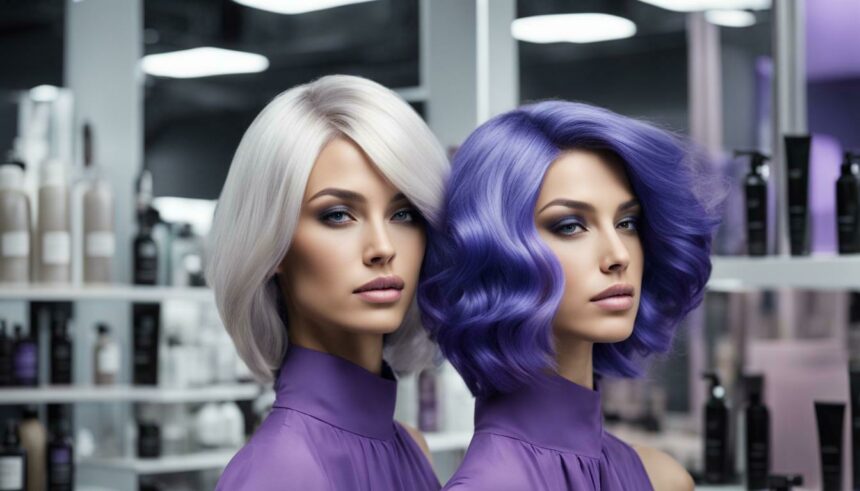When it comes to toning shampoos, blue and purple shampoos are two of the most commonly used for color-treated hair. Although they both help combat brassiness and color fading, they work differently and are suited for different hair shades. In this article, we will explore the difference between blue shampoo and purple shampoo and help you determine which is right for you.
Key Takeaways:
- Blue shampoo and purple shampoo are toning shampoos designed to combat color fading and brassiness in color-treated hair.
- Blue shampoo contains blue pigments to counteract warm, orange, or yellow tones, while purple shampoo contains purple pigments to neutralize unwanted yellow tones.
- The choice between blue and purple shampoo depends on your specific hair color and desired results.
- Some individuals may benefit from using both blue and purple shampoos to address both warm and yellow tones.
- Regular use of toning shampoos can help maintain the vibrancy and longevity of color-treated hair.
What is Blue Shampoo?
Blue shampoo is a type of toning shampoo that is specifically designed to counteract unwanted warm tones in color-treated hair, making it an essential product for hair color maintenance. Toning shampoos, such as blue shampoo, work by neutralizing brassiness, which often occurs in blonde, gray, or highlighted hair.
Blue shampoo contains blue pigments that help to cancel out orange and yellow tones that may develop over time. Regular use of blue shampoo can help maintain cool, vibrant tones and prevent brassiness in color-treated hair.
How Does Blue Shampoo Work?
Blue shampoo is a hair care product designed to help maintain the vibrant color of color-treated hair and prevent brassiness, especially in shades of blonde, gray, or highlighted hair. This type of toning shampoo works by depositing blue pigments onto the hair strands to neutralize unwanted warm, orange, or yellow tones.
The blue pigments in blue shampoo work by canceling out the opposite color on the color wheel, which is orange or yellow. By depositing blue pigments onto the hair strands, blue shampoo helps to restore a cooler, vibrant tone and prevent brassiness from developing. Regular use of blue shampoo can ensure color-treated hair maintains a consistent, cool tone, and free of unwanted brassiness.
Blue shampoo is particularly useful for those with color-treated hair since hair dye can often fade or turn brassy as time goes by. By using blue shampoo regularly, you can help maintain the vibrancy and longevity of your hair color. It’s important to note that blue shampoo is most effective on hair that has more orange or brassy tones and may not be as suitable for hair with yellow tones.
Incorporating blue shampoo into your hair care routine is simple. Replace your usual shampoo with blue shampoo once or twice a week, depending on the level on brassiness present in your hair. Massage the shampoo onto wet hair and leave it on for a few minutes before rinsing. Follow up with a conditioner for best results.

What is Purple Shampoo?
Purple shampoo is a type of toning shampoo that is widely used to combat brassiness in blonde or silver/gray hair. It contains purple pigments that work specifically to neutralize unwanted yellow tones and leave the hair looking cooler and more vibrant.
Unlike regular shampoos, แชมพูลดรังแค 2023 should be used on damp hair and left on for a few minutes before rinsing thoroughly. This allows the pigments to deposit onto the hair strands and work their magic.
Purple shampoo is particularly beneficial for color-treated hair, as it helps maintain the desired cool tones. It’s also suitable for those with blonde hair who struggle with unwanted yellow tones.
If you have darker hair, purple shampoo may not be as effective. However, you can still benefit from using a toning shampoo specifically designed for your hair color.
Tip: Using purple shampoo too often can lead to an excess of purple pigments in the hair, resulting in a dull or grayish appearance. It’s recommended to use it once or twice a week or as needed.
| Key Points: | Purple shampoo is a toning shampoo designed to neutralize unwanted yellow tones in blonde or silver/gray hair. |
|---|---|
| It contains purple pigments that deposit onto the hair strands and work to maintain the desired cool tones. | |
| Purple shampoo should be used on damp hair and left on for a few minutes before rinsing thoroughly. | |
| It’s beneficial for color-treated hair and those with blonde hair who struggle with unwanted yellow tones. |
How Does Purple Shampoo Work?
Purple shampoo is a popular hair care product used to combat brassiness, particularly in blonde or silver/gray hair. But how does it work? Essentially, the purple pigments in the shampoo neutralize unwanted yellow tones, leaving the hair cooler and more vibrant.
When blonde hair is exposed to water, sunlight, and other external factors, it can develop yellow tones over time. This is where purple shampoo comes in handy. By depositing purple pigments onto the hair strands, the shampoo balances out the yellow hues, preventing brassiness and maintaining the desired cool tones.
Similar to blue shampoo, purple shampoo needs to be used regularly for best results. Depending on the intensity of the yellow tones, you may need to use purple shampoo more or less frequently. When using purple shampoo, it’s essential to follow the instructions carefully, as overuse or leaving it in for too long can result in a purple tint to the hair.
Overall, purple shampoo is an effective color-correcting shampoo that can help maintain blonde hair’s vibrancy and longevity. If you have blonde or silver/gray hair with unwanted yellow tones, incorporating purple shampoo into your hair care routine can be a game-changer.
Which One Should You Choose: Blue Shampoo or Purple Shampoo?
When it comes to choosing between blue shampoo and purple shampoo, the decision largely depends on your hair color and the specific tones you want to neutralize. Purple shampoo is ideal if you have blonde or silver hair with yellow tones that need to be neutralized. On the other hand, blue shampoo is a better choice if you have blonde, gray, or highlighted hair with more orange or brassy tones that need to be corrected.
It’s important to note that both blue and purple shampoos work in similar ways, but they contain different pigments that target specific tones. Using the wrong one may not give you the desired results.
If you have hair with both warm and yellow tones, you may benefit from using both blue and purple shampoos. By alternating between the two, you can address both brassiness and unwanted yellow tones, achieving a more balanced and vibrant hair color. However, it’s recommended to use them on different days to avoid over-toning and damaging your hair.
Ultimately, the choice between blue shampoo and purple shampoo is a personal one that depends on your hair color and desired results. By using the appropriate toning shampoo regularly, you can maintain a vibrant and fresh hair color and prevent unwanted brassiness.
Using Blue and Purple Shampoos Together
If your color-treated hair has both warm and yellow tones, alternating between blue and purple shampoos can be the most effective option. Using both blue and purple shampoos together can help maintain the desired cool tones of blonde, gray, or highlighted hair, while also neutralizing unwanted warm tones and brassiness.
When using blue and purple shampoos together, it is important to not overdo it. Overuse of toning shampoos can result in hair becoming too cool or even tinted with blue or purple tones. It is recommended to alternate between the two shampoos every other wash or as needed to maintain the desired hair color.
It is also essential to follow up with a good hair care routine to keep your hair healthy and hydrated. This includes using a moisturizing conditioner, avoiding excessive heat styling, and protecting your hair from UV rays. By using blue and purple shampoos in conjunction with proper hair care products, you can achieve the best possible results for your color-treated hair.
Conclusion
Blue shampoo and purple shampoo are both effective toning shampoos that combat color fading and brassiness in different hair shades. While blue shampoo is more suitable for blonde, gray, or highlighted hair with orange or brassy tones, purple shampoo works best for hair with a lot of yellow tones. Regular use of these toning shampoos can help maintain the vibrancy and longevity of color-treated hair.
It is important to remember that toning shampoos are not meant to replace regular shampoos but rather to be used in conjunction with them. Also, be mindful of how often you use them as frequent use can cause dryness and damage to your hair. It is crucial to strike a balance between using these products to maintain color vibrancy and not overdoing it.
Ultimately, the choice between blue shampoo and purple shampoo depends on your individual hair color and desired results. Some people with hair that has both warm and yellow tones might benefit from using both, alternating between the two to address both brassiness and unwanted yellow tones, achieving a more balanced and vibrant hair color. Whatever your choice, be sure to make toning shampoos a regular part of your hair care routine for optimal results in hair color maintenance.
FAQ
Q: What is the difference between blue shampoo and purple shampoo?
A: Blue shampoo is designed to neutralize unwanted warm tones in hair, particularly in color-treated hair, while purple shampoo is specifically formulated to combat brassiness in blonde or silver/gray hair by neutralizing yellow tones.
Q: How does blue shampoo work?
A: Blue shampoo works by depositing blue pigments onto the hair strands to cancel out warm, orange, or yellow tones that may develop over time, especially in color-treated hair.
Q: What is purple shampoo used for?
A: Purple shampoo is used to counteract unwanted yellow tones in blonde or silver/gray hair, leaving the hair looking cooler and more vibrant.
Q: How does purple shampoo work?
A: Purple shampoo works by depositing purple pigments onto the hair strands, which neutralize the yellow tones that tend to develop in blonde or silver hair.
Q: Should I choose blue shampoo or purple shampoo?
A: The choice between blue shampoo and purple shampoo depends on your specific hair color and desired results. If you have blonde hair with yellow tones, purple shampoo is more suitable. If you have blonde, gray, or highlighted hair with orange or brassy tones, blue shampoo is the better option.
Q: Can I use blue and purple shampoos together?
A: Yes, some individuals with hair that has both warm and yellow tones may benefit from using both blue and purple shampoos. By alternating between the two, you can address both brassiness and unwanted yellow tones for a more balanced and vibrant hair color.
Q: What are the benefits of using toning shampoos like blue and purple shampoos?
A: Toning shampoos help combat color fading and brassiness in color-treated hair. Regular use of these shampoos can help maintain the vibrancy and longevity of your hair color.











